Home / Cyclohexane Conformations
Conformations and Cycloalkanes
Cyclohexane Conformations
Last updated: November 21st, 2024 |
Conformations of Cyclohexane (and Cyclopentane)
In the last post, we saw that ring strain of cyclopropane and cyclobutane were 27 and 26 kcal/mol respectively. They are the unhappiest of rings – constrained into uncomfortable angles, with hydrogens forced by geometry to grumpily line up side-by-side with their repulsive neighbours.
The situation for cyclopentane (ring strain: 6 kcal/mol) and cyclohexane (ring strain: 0 kcal/mol) is much happier.
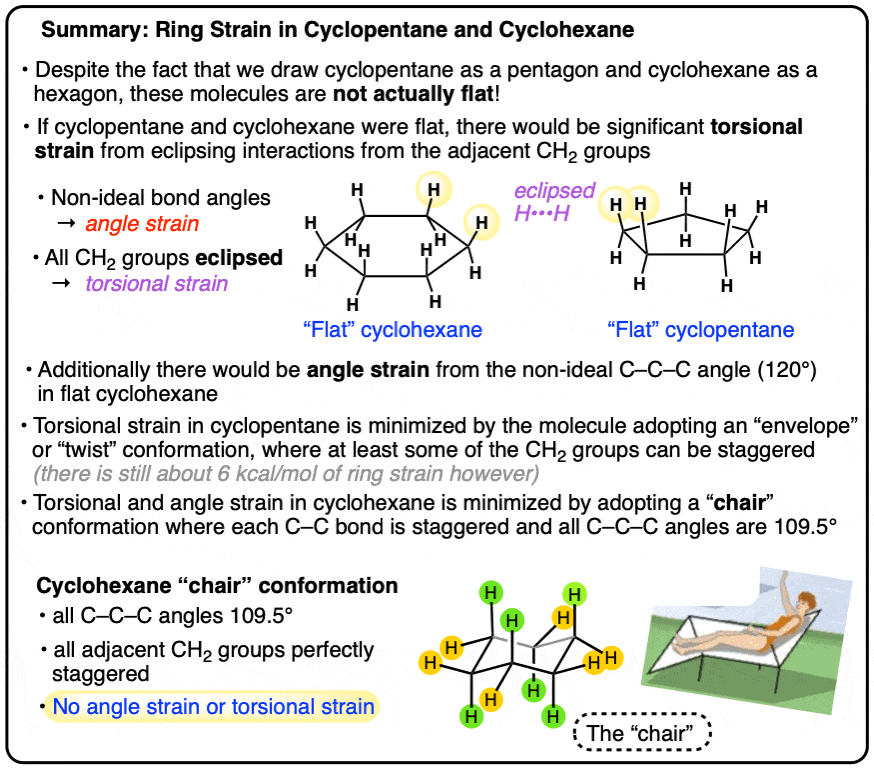
Table of Contents
- Why Aren’t The Bond Angles Of Cyclohexane 120° ?
- The “Flat”, “Envelope” and “Twist” Conformations of Cyclopentane
- The Five Key Conformations of Cyclohexane
- The “Flat” Conformation of Cyclohexane
- The “Half Chair” Conformation of Cyclohexane
- The “Boat” Conformation of Cyclohexane (but it’s actually more like a hammock)
- The “Twist Boat” Conformation of Cyclohexane
- The “Chair” Conformation of Cyclohexane
- Energy Diagram: The 5 Key Conformations of Cyclohexane
- Notes
- (Advanced) References and Further Reading
1. Why Aren’t The Bond Angles Of Cyclohexane 120 Degrees?
First, though, the answer to the riddle from the last post. At first glance, the fact that cyclopentane is more strained than cyclohexane might seem strange because pentagons have bond angle of 108° (very close to the ideal tetrahedral angle of 109°) and hexagons have a bond angle of 120°.
Shouldn’t we expect that cyclohexane is more strained than cyclopentane, not less? What’s going on?

You might see the key fallacy in this line of thinking. What’s the key difference between a pentagon and cyclopentane, or a hexagon and cyclohexane?
The key difference is that the molecules don’t necessarily have to be flat! In fact, as we saw for cyclobutane, “flatness” is disfavored, because it leads to eclipsed C-C bonds, which can have considerable torsional stain. In fact we saw that the dominant conformation for cyclobutane was the “puckered” conformation, where one of the carbons pokes out of the plane created by the other 3 carbons. This relieves torsional strain.
2. The “Flat”, “Envelope”, and “Twist” Conformations Of Cyclopentane
Similarly, for cyclopentane, the “flat” conformation has all of its C-C bonds eclipsed and has considerable torsional strain (about 10 kcal/mol). However, since there is some flexibility, what we in fact observe is two dominant conformations for cyclopentane (of comparable energy), the “envelope” and the “twist”. While each of these conformations has some torsional strain (the C-C bonds are not perfectly staggered), both of these have considerably less torsional strain than flat cyclopentane.
[By the way, these conformations of cyclopentane are not just of purely academic interest – ribose and deoxyribose are 5-membered rings whose conformations have tremendous biological relevance. See Note 1 at bottom]
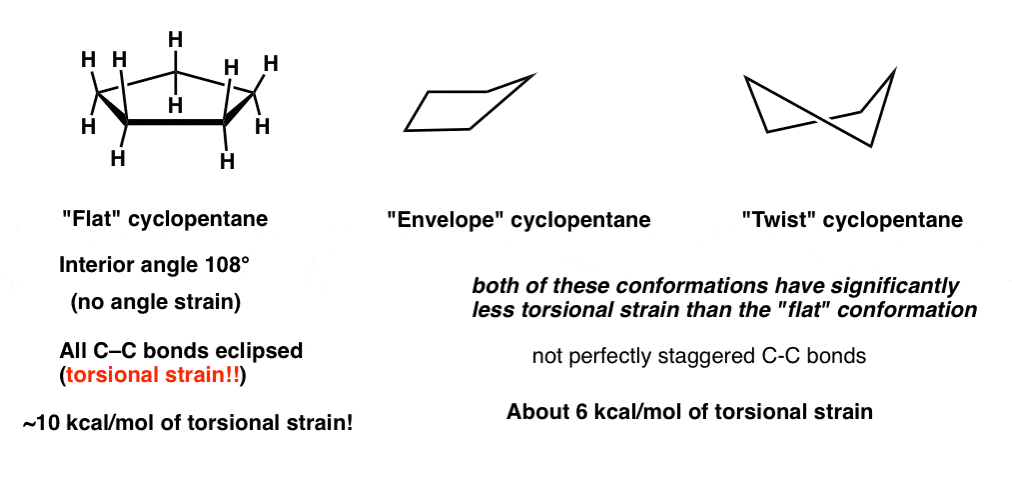
3. The Five Key Conformations Of Cyclohexane
So that helps to explain why cyclopentane has at least some ring strain.
What about cyclohexane?
Glad you asked! Well, find a comfy thing to sit in – a chair, or a hammock if you will, because over the next few posts, we are going to talk and talk and talk about cyclohexane, and then talk some more. There will be no ring more important to us in this course than cyclohexane.
In this post, however, I just want to sketch out the basics. What are the different conformations (shapes) that cyclohexane has, how do they differ in energy, and why? For best results, I suggest making a model of cyclohexane.
[When many students hear someone say, “make a model”, it’s often like hearing, “go ask your mother”, so really, do what you want. But I promise that it will help as we go through this.]
4. The “Flat” Conformation Of Cyclohexane
Flat cyclohexane is very strained (about 20 kcal/mol). Not only is there angle strain (with internal angles at 120°, above the ideal angle of 109°) but every C-C bond is eclipsed, so there is also tremendous torsional strain. In solution, the flat conformation of cyclohexane is generally of too high an energy to be observed.

5. The “Half Chair” Conformation Of Cyclohexane
If one takes one end of the cyclohexane and “pulls” it up, then we will have a “half-chair” conformation of cyclohexane. If you try this with a model you will note that there will be rotations about 4 different C-C bonds, and this will result in them no longer being completely eclipsed. Furthermore the bond angles upon doing so will more closely resemble the ideal tetrahedral bond angles of 109°.
This results in significantly less torsional strain and angle strain. The strain energy relative to a theoretical “unstrained” ring is about 10.8 kcal/mol.
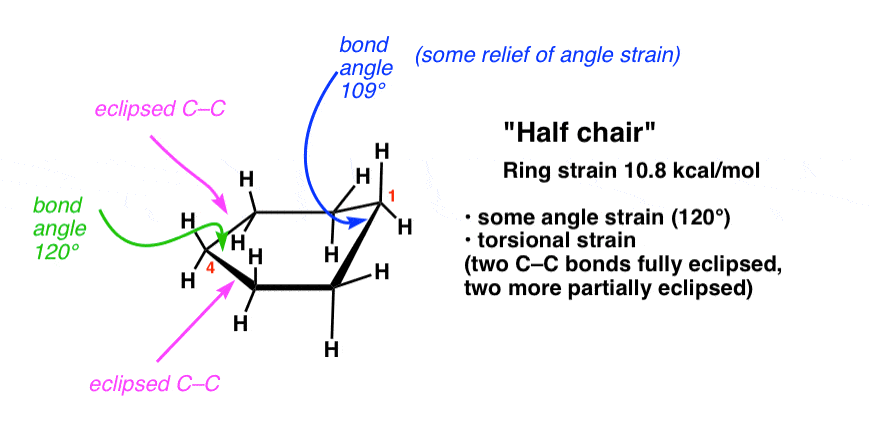
6. The “BOAT” Conformation of Cyclohexane
Taking the other end of the half-chair and pulling it up creates a structure which resembles a boat (or, as I modestly propose, a hammock). There is no longer significant angle strain, since all internal angles can now be 109 degrees. There is still torsional strain, however, as if you look carefully you will see that along two different C-C bonds, the C-H bonds are all eclipsed [there’s a total of 4 eclipsing H-H interactions].
Furthermore, there is an additional source of strain in the hydrogens of the “prows” of the boat. In the boat conformation these hydrogens are held together in such close proximity that their electron clouds come close enough together to repel, an effect known as Van Der Waals strain. Sometimes this interaction is known as the “flagpole” interaction. The ring strain in the boat is about 7.0 kcal/mol.
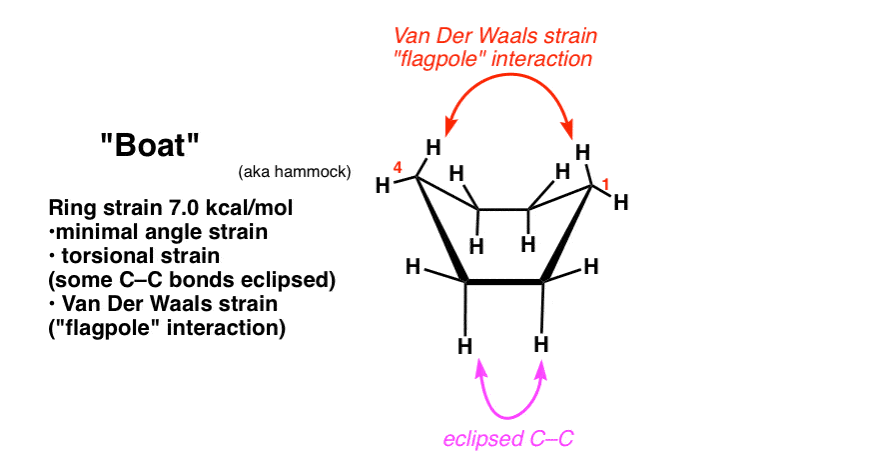
7. The “Twist Boat” Conformation Of Cyclohexane
. A significant portion of Van Der Waals strain of the boat can be relieved by a slight rotation of the bonds, resulting in a conformation known as the “twist boat”.
Drawings don’t do it adequate justice – for this one you really need to build a model to see how a slight twisting of the structure can result in less strain. There is still significant torsional strain since there are two C-C bonds about which the hydrogens are not perfectly staggered.

8. The “Chair” Conformation Of Cyclohexane
If one starts with the “half chair” and then pulls the “flat” end in the opposite direction of the carbon that is poking out of the plane, the result is a structure with 4 carbons in the same plane and one carbon each poking above and below the plane. This resembles a deck chair, so it goes by this name.
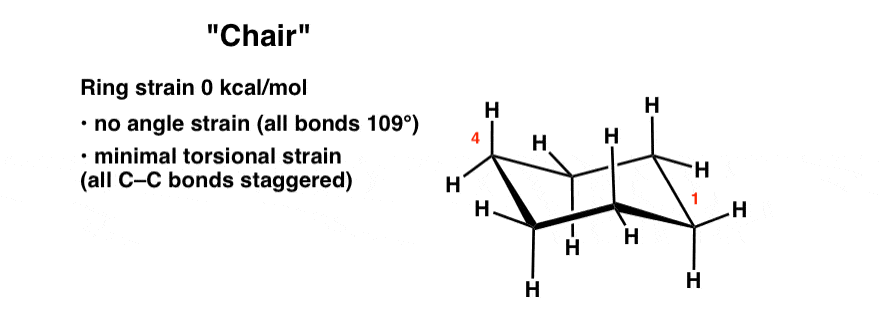
The chair is a perfectly unstrained molecule. There are no eclipsing interactions; the conformation along each C-C bond is staggered. Furthermore the orientations of the atoms about each carbon are perfectly tetrahedral. Since it lacks ring strain and is of lowest energy, the chair conformation is the dominant conformation that cyclohexane will be found in solution.
Time for some bold type: The chair conformation is the most important conformation of cyclohexane to understand.
9. Energy Diagram: The 5 Key Conformations Of Cyclohexane
Putting all of these conformations together, we can obtain this chart, with highest energy at the top:
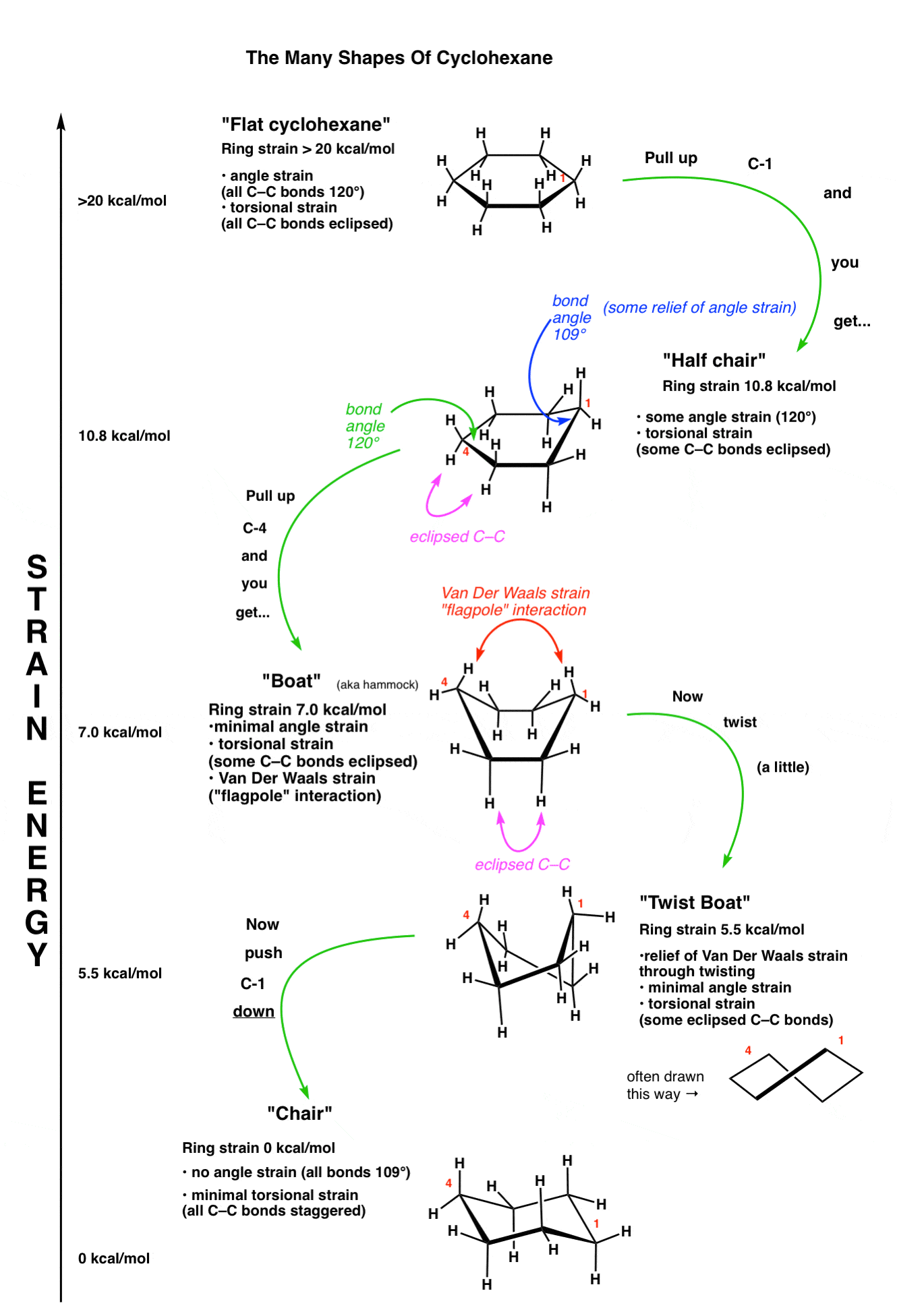
If many of these conformations and shapes still seem strange to you, don’t worry! In the next post we are going to talk in more detail about the cyclohexane chair conformation, including how to draw it properly.
Notes
Related Articles
Note 1. On sugars and conformations. Quote from my friend Jon, who is much more knowledgable than myself about these matters:
“In double helices – B–DNA (the classic double helix) basically has sugars with a south pucker. Double-stranded RNA, and also A-DNA (found in other sequences/conditions) basically has sugars with a north pucker.
Interestingly, kinases that are needed to activate nucleoside drugs (AZT and many others) recognize the puckers and so the pucker of a nucleoside can be key to allowing it to be activated as the triphosphate and incorporated into DNA. Victor Marquez of the NCI (NIH) is the authority in this area of nucleoside conformations and their biological activity.”
(Advanced) References and Further Reading
Cyclopentane and cyclohexane are significantly less strained than other alicyclic hydrocarbons, because they are at the ‘sweet spot’ where they are flexible enough to avoid unfavorable diaxial or syn-pentane interactions.
- THE STRUCTURE OF ALICYCLIC COMPOUNDS
G. Aston, S. C. Schumann, H. L. Fink, and P. M. Doty
Journal of the American Chemical Society 1941, 63 (7), 2029-2030
DOI: 10.1021/ja01852a508
An early paper that suggested cyclopentane has a non-planar structure based on vibrational (IR or Raman) data. - Conformations and Strain Energy of Cyclopentane and its Derivatives
Kenneth S. Pitzer and Wilm E. Donath
Journal of the American Chemical Society 1959, 81 (13), 3213-3218
DOI: 1021/ja01522a014
An early paper which calculates the strain energy of cyclopentane to be 8.5 kcal/mol. - Vibrational Spectra and Structure of Cyclopentane and its Isotopomers
Esther J. Ocola, Leslie E. Bauman, and Jaan Laane
The Journal of Physical Chemistry A 2011, 115 (24), 6531-6542
DOI: 1021/jp2032934
A more recent paper which does a thorough combined experimental and theoretical analysis of the potential energy surface of cyclopentane. Interestingly, it is extremely small – the difference in energy between the twist and bent forms is less than 0.1 kcal/mol. - Ueber Polyacetylenverbindungen
Adolf Baeyer
Ber. 1885, 18 (2), 2269-2281
DOI: 10.1002/cber.18850180296
The original paper on ring strain by the legendary chemist Adolf von Baeyer. Even though this paper is titled on a completely different topic, ring strain is discussed at the very end of the paper. - Evaluation of strain in hydrocarbons. The strain in adamantane and its origin
Paul von R. Schleyer, James Earl Williams, and Blanchard K. R.
Journal of the American Chemical Society 1970, 92 (8), 2377-2386
DOI: 1021/ja00711a030
An early paper by Prof. P. v. R. Schleyer before he moved to Germany in the 1970’s which uses a different set of calculations than those employed previously, arriving at a value of 1.35 kcal/mol for the strain of cyclohexane. Table
VII in this paper has a large collection of strain energies of various hydrocarbons, including cyclopentane, cyclohexane, and adamantane (7.19. 1.35 and 6.48 kcal/mol, respectively), especially noteworthy since up to this point adamantane was thought to be relatively “strain-free”. (Adamantane was a pet topic of his, as one of his most highly-cited papers is a 1-page communication in JACS on the simple synthesis of adamantane.) - The Concept of Strain in Organic Chemistry
Kenneth B. Wiberg
Angew. Chem. Int. Ed. 1986, 25 (4), 312-322
DOI: 10.1002/anie.198603121
Ring strain can also be called ‘angle strain’, resulting from the distortion of bond angles, increasing the energy content of the molecule. This paper also discusses the propellanes, an interesting class of small strained molecules. While [1.1.1]propellane can be isolated, [2.2.1] has not been obtained as a pure substance yet. This is due to the strength of the central bond towards homolytic cleavage, which provides a path for decomposition. This energy is strongly influenced by the difference in the strain energy between the reactant and the resulting diradical. In [1.1.1]propellane, the difference is 65 kcal/mol, while in [2.2.1]propellane, it is 5 kcal/mol. - Ueber die geometrischen Isomerien der Hexamethylenderivate
Sachse
Chem. Ber. 1890, 23 (1), 1363-1370
DOI: 10.1002/cber.189002301216 - Über die Konfigurationen der Polymethylenringe
Sachse
Z. Phys. Chem. 1892, 10U (1), 203-241
DOI: 10.1515/zpch-1892-1013
Sachse was the first to have the insight to recognize that cyclohexane does not need to be flat, and furthermore adoption of a bent shape (which we now call the “chair”) alleviates its angle strain. Unfortunately he passed away in 1893 before being able to further elaborate his ideas.
00 General Chemistry Review
01 Bonding, Structure, and Resonance
- How Do We Know Methane (CH4) Is Tetrahedral?
- Hybrid Orbitals and Hybridization
- How To Determine Hybridization: A Shortcut
- Orbital Hybridization And Bond Strengths
- Sigma bonds come in six varieties: Pi bonds come in one
- A Key Skill: How to Calculate Formal Charge
- The Four Intermolecular Forces and How They Affect Boiling Points
- 3 Trends That Affect Boiling Points
- How To Use Electronegativity To Determine Electron Density (and why NOT to trust formal charge)
- Introduction to Resonance
- How To Use Curved Arrows To Interchange Resonance Forms
- Evaluating Resonance Forms (1) - The Rule of Least Charges
- How To Find The Best Resonance Structure By Applying Electronegativity
- Evaluating Resonance Structures With Negative Charges
- Evaluating Resonance Structures With Positive Charge
- Exploring Resonance: Pi-Donation
- Exploring Resonance: Pi-acceptors
- In Summary: Evaluating Resonance Structures
- Drawing Resonance Structures: 3 Common Mistakes To Avoid
- How to apply electronegativity and resonance to understand reactivity
- Bond Hybridization Practice
- Structure and Bonding Practice Quizzes
- Resonance Structures Practice
02 Acid Base Reactions
- Introduction to Acid-Base Reactions
- Acid Base Reactions In Organic Chemistry
- The Stronger The Acid, The Weaker The Conjugate Base
- Walkthrough of Acid-Base Reactions (3) - Acidity Trends
- Five Key Factors That Influence Acidity
- Acid-Base Reactions: Introducing Ka and pKa
- How to Use a pKa Table
- The pKa Table Is Your Friend
- A Handy Rule of Thumb for Acid-Base Reactions
- Acid Base Reactions Are Fast
- pKa Values Span 60 Orders Of Magnitude
- How Protonation and Deprotonation Affect Reactivity
- Acid Base Practice Problems
03 Alkanes and Nomenclature
- Meet the (Most Important) Functional Groups
- Condensed Formulas: Deciphering What the Brackets Mean
- Hidden Hydrogens, Hidden Lone Pairs, Hidden Counterions
- Don't Be Futyl, Learn The Butyls
- Primary, Secondary, Tertiary, Quaternary In Organic Chemistry
- Branching, and Its Affect On Melting and Boiling Points
- The Many, Many Ways of Drawing Butane
- Wedge And Dash Convention For Tetrahedral Carbon
- Common Mistakes in Organic Chemistry: Pentavalent Carbon
- Table of Functional Group Priorities for Nomenclature
- Summary Sheet - Alkane Nomenclature
- Organic Chemistry IUPAC Nomenclature Demystified With A Simple Puzzle Piece Approach
- Boiling Point Quizzes
- Organic Chemistry Nomenclature Quizzes
04 Conformations and Cycloalkanes
- Staggered vs Eclipsed Conformations of Ethane
- Conformational Isomers of Propane
- Newman Projection of Butane (and Gauche Conformation)
- Introduction to Cycloalkanes
- Geometric Isomers In Small Rings: Cis And Trans Cycloalkanes
- Calculation of Ring Strain In Cycloalkanes
- Cycloalkanes - Ring Strain In Cyclopropane And Cyclobutane
- Cyclohexane Conformations
- Cyclohexane Chair Conformation: An Aerial Tour
- How To Draw The Cyclohexane Chair Conformation
- The Cyclohexane Chair Flip
- The Cyclohexane Chair Flip - Energy Diagram
- Substituted Cyclohexanes - Axial vs Equatorial
- Ranking The Bulkiness Of Substituents On Cyclohexanes: "A-Values"
- Cyclohexane Chair Conformation Stability: Which One Is Lower Energy?
- Fused Rings - Cis-Decalin and Trans-Decalin
- Naming Bicyclic Compounds - Fused, Bridged, and Spiro
- Bredt's Rule (And Summary of Cycloalkanes)
- Newman Projection Practice
- Cycloalkanes Practice Problems
05 A Primer On Organic Reactions
- The Most Important Question To Ask When Learning a New Reaction
- Curved Arrows (for reactions)
- Nucleophiles and Electrophiles
- The Three Classes of Nucleophiles
- Nucleophilicity vs. Basicity
- What Makes A Good Nucleophile?
- What Makes A Good Leaving Group?
- 3 Factors That Stabilize Carbocations
- Equilibrium and Energy Relationships
- 7 Factors that stabilize negative charge in organic chemistry
- 7 Factors That Stabilize Positive Charge in Organic Chemistry
- What's a Transition State?
- Hammond's Postulate
- Learning Organic Chemistry Reactions: A Checklist (PDF)
- Introduction to Oxidative Cleavage Reactions
06 Free Radical Reactions
- Bond Dissociation Energies = Homolytic Cleavage
- Free Radical Reactions
- 3 Factors That Stabilize Free Radicals
- What Factors Destabilize Free Radicals?
- Bond Strengths And Radical Stability
- Free Radical Initiation: Why Is "Light" Or "Heat" Required?
- Initiation, Propagation, Termination
- Monochlorination Products Of Propane, Pentane, And Other Alkanes
- Selectivity In Free Radical Reactions
- Selectivity in Free Radical Reactions: Bromination vs. Chlorination
- Halogenation At Tiffany's
- Allylic Bromination
- Bonus Topic: Allylic Rearrangements
- In Summary: Free Radicals
- Synthesis (2) - Reactions of Alkanes
- Free Radicals Practice Quizzes
07 Stereochemistry and Chirality
- Types of Isomers: Constitutional Isomers, Stereoisomers, Enantiomers, and Diastereomers
- How To Draw The Enantiomer Of A Chiral Molecule
- How To Draw A Bond Rotation
- Introduction to Assigning (R) and (S): The Cahn-Ingold-Prelog Rules
- Assigning Cahn-Ingold-Prelog (CIP) Priorities (2) - The Method of Dots
- Enantiomers vs Diastereomers vs The Same? Two Methods For Solving Problems
- Assigning R/S To Newman Projections (And Converting Newman To Line Diagrams)
- How To Determine R and S Configurations On A Fischer Projection
- The Meso Trap
- Optical Rotation, Optical Activity, and Specific Rotation
- Optical Purity and Enantiomeric Excess
- What's a Racemic Mixture?
- Chiral Allenes And Chiral Axes
- Stereochemistry Practice Problems and Quizzes
08 Substitution Reactions
- Nucleophilic Substitution Reactions - Introduction
- Two Types of Nucleophilic Substitution Reactions
- The SN2 Mechanism
- Why the SN2 Reaction Is Powerful
- The SN1 Mechanism
- The Conjugate Acid Is A Better Leaving Group
- Comparing the SN1 and SN2 Reactions
- Polar Protic? Polar Aprotic? Nonpolar? All About Solvents
- Steric Hindrance is Like a Fat Goalie
- Common Blind Spot: Intramolecular Reactions
- Substitution Practice - SN1
- Substitution Practice - SN2
09 Elimination Reactions
- Elimination Reactions (1): Introduction And The Key Pattern
- Elimination Reactions (2): The Zaitsev Rule
- Elimination Reactions Are Favored By Heat
- Two Elimination Reaction Patterns
- The E1 Reaction
- The E2 Mechanism
- E1 vs E2: Comparing the E1 and E2 Reactions
- Antiperiplanar Relationships: The E2 Reaction and Cyclohexane Rings
- Bulky Bases in Elimination Reactions
- Comparing the E1 vs SN1 Reactions
- Elimination (E1) Reactions With Rearrangements
- E1cB - Elimination (Unimolecular) Conjugate Base
- Elimination (E1) Practice Problems And Solutions
- Elimination (E2) Practice Problems and Solutions
10 Rearrangements
11 SN1/SN2/E1/E2 Decision
- Identifying Where Substitution and Elimination Reactions Happen
- Deciding SN1/SN2/E1/E2 (1) - The Substrate
- Deciding SN1/SN2/E1/E2 (2) - The Nucleophile/Base
- SN1 vs E1 and SN2 vs E2 : The Temperature
- Deciding SN1/SN2/E1/E2 - The Solvent
- Wrapup: The Key Factors For Determining SN1/SN2/E1/E2
- Alkyl Halide Reaction Map And Summary
- SN1 SN2 E1 E2 Practice Problems
12 Alkene Reactions
- E and Z Notation For Alkenes (+ Cis/Trans)
- Alkene Stability
- Alkene Addition Reactions: "Regioselectivity" and "Stereoselectivity" (Syn/Anti)
- Stereoselective and Stereospecific Reactions
- Hydrohalogenation of Alkenes and Markovnikov's Rule
- Hydration of Alkenes With Aqueous Acid
- Rearrangements in Alkene Addition Reactions
- Halogenation of Alkenes and Halohydrin Formation
- Oxymercuration Demercuration of Alkenes
- Hydroboration Oxidation of Alkenes
- m-CPBA (meta-chloroperoxybenzoic acid)
- OsO4 (Osmium Tetroxide) for Dihydroxylation of Alkenes
- Palladium on Carbon (Pd/C) for Catalytic Hydrogenation of Alkenes
- Cyclopropanation of Alkenes
- A Fourth Alkene Addition Pattern - Free Radical Addition
- Alkene Reactions: Ozonolysis
- Summary: Three Key Families Of Alkene Reaction Mechanisms
- Synthesis (4) - Alkene Reaction Map, Including Alkyl Halide Reactions
- Alkene Reactions Practice Problems
13 Alkyne Reactions
- Acetylides from Alkynes, And Substitution Reactions of Acetylides
- Partial Reduction of Alkynes With Lindlar's Catalyst
- Partial Reduction of Alkynes With Na/NH3 To Obtain Trans Alkenes
- Alkyne Hydroboration With "R2BH"
- Hydration and Oxymercuration of Alkynes
- Hydrohalogenation of Alkynes
- Alkyne Halogenation: Bromination, Chlorination, and Iodination of Alkynes
- Alkyne Reactions - The "Concerted" Pathway
- Alkenes To Alkynes Via Halogenation And Elimination Reactions
- Alkynes Are A Blank Canvas
- Synthesis (5) - Reactions of Alkynes
- Alkyne Reactions Practice Problems With Answers
14 Alcohols, Epoxides and Ethers
- Alcohols - Nomenclature and Properties
- Alcohols Can Act As Acids Or Bases (And Why It Matters)
- Alcohols - Acidity and Basicity
- The Williamson Ether Synthesis
- Ethers From Alkenes, Tertiary Alkyl Halides and Alkoxymercuration
- Alcohols To Ethers via Acid Catalysis
- Cleavage Of Ethers With Acid
- Epoxides - The Outlier Of The Ether Family
- Opening of Epoxides With Acid
- Epoxide Ring Opening With Base
- Making Alkyl Halides From Alcohols
- Tosylates And Mesylates
- PBr3 and SOCl2
- Elimination Reactions of Alcohols
- Elimination of Alcohols To Alkenes With POCl3
- Alcohol Oxidation: "Strong" and "Weak" Oxidants
- Demystifying The Mechanisms of Alcohol Oxidations
- Protecting Groups For Alcohols
- Thiols And Thioethers
- Calculating the oxidation state of a carbon
- Oxidation and Reduction in Organic Chemistry
- Oxidation Ladders
- SOCl2 Mechanism For Alcohols To Alkyl Halides: SN2 versus SNi
- Alcohol Reactions Roadmap (PDF)
- Alcohol Reaction Practice Problems
- Epoxide Reaction Quizzes
- Oxidation and Reduction Practice Quizzes
15 Organometallics
- What's An Organometallic?
- Formation of Grignard and Organolithium Reagents
- Organometallics Are Strong Bases
- Reactions of Grignard Reagents
- Protecting Groups In Grignard Reactions
- Synthesis Problems Involving Grignard Reagents
- Grignard Reactions And Synthesis (2)
- Organocuprates (Gilman Reagents): How They're Made
- Gilman Reagents (Organocuprates): What They're Used For
- The Heck, Suzuki, and Olefin Metathesis Reactions (And Why They Don't Belong In Most Introductory Organic Chemistry Courses)
- Reaction Map: Reactions of Organometallics
- Grignard Practice Problems
16 Spectroscopy
- Degrees of Unsaturation (or IHD, Index of Hydrogen Deficiency)
- Conjugation And Color (+ How Bleach Works)
- Introduction To UV-Vis Spectroscopy
- UV-Vis Spectroscopy: Absorbance of Carbonyls
- UV-Vis Spectroscopy: Practice Questions
- Bond Vibrations, Infrared Spectroscopy, and the "Ball and Spring" Model
- Infrared Spectroscopy: A Quick Primer On Interpreting Spectra
- IR Spectroscopy: 4 Practice Problems
- 1H NMR: How Many Signals?
- Homotopic, Enantiotopic, Diastereotopic
- Diastereotopic Protons in 1H NMR Spectroscopy: Examples
- 13-C NMR - How Many Signals
- Liquid Gold: Pheromones In Doe Urine
- Natural Product Isolation (1) - Extraction
- Natural Product Isolation (2) - Purification Techniques, An Overview
- Structure Determination Case Study: Deer Tarsal Gland Pheromone
17 Dienes and MO Theory
- What To Expect In Organic Chemistry 2
- Are these molecules conjugated?
- Conjugation And Resonance In Organic Chemistry
- Bonding And Antibonding Pi Orbitals
- Molecular Orbitals of The Allyl Cation, Allyl Radical, and Allyl Anion
- Pi Molecular Orbitals of Butadiene
- Reactions of Dienes: 1,2 and 1,4 Addition
- Thermodynamic and Kinetic Products
- More On 1,2 and 1,4 Additions To Dienes
- s-cis and s-trans
- The Diels-Alder Reaction
- Cyclic Dienes and Dienophiles in the Diels-Alder Reaction
- Stereochemistry of the Diels-Alder Reaction
- Exo vs Endo Products In The Diels Alder: How To Tell Them Apart
- HOMO and LUMO In the Diels Alder Reaction
- Why Are Endo vs Exo Products Favored in the Diels-Alder Reaction?
- Diels-Alder Reaction: Kinetic and Thermodynamic Control
- The Retro Diels-Alder Reaction
- The Intramolecular Diels Alder Reaction
- Regiochemistry In The Diels-Alder Reaction
- The Cope and Claisen Rearrangements
- Electrocyclic Reactions
- Electrocyclic Ring Opening And Closure (2) - Six (or Eight) Pi Electrons
- Diels Alder Practice Problems
- Molecular Orbital Theory Practice
18 Aromaticity
- Introduction To Aromaticity
- Rules For Aromaticity
- Huckel's Rule: What Does 4n+2 Mean?
- Aromatic, Non-Aromatic, or Antiaromatic? Some Practice Problems
- Antiaromatic Compounds and Antiaromaticity
- The Pi Molecular Orbitals of Benzene
- The Pi Molecular Orbitals of Cyclobutadiene
- Frost Circles
- Aromaticity Practice Quizzes
19 Reactions of Aromatic Molecules
- Electrophilic Aromatic Substitution: Introduction
- Activating and Deactivating Groups In Electrophilic Aromatic Substitution
- Electrophilic Aromatic Substitution - The Mechanism
- Ortho-, Para- and Meta- Directors in Electrophilic Aromatic Substitution
- Understanding Ortho, Para, and Meta Directors
- Why are halogens ortho- para- directors?
- Disubstituted Benzenes: The Strongest Electron-Donor "Wins"
- Electrophilic Aromatic Substitutions (1) - Halogenation of Benzene
- Electrophilic Aromatic Substitutions (2) - Nitration and Sulfonation
- EAS Reactions (3) - Friedel-Crafts Acylation and Friedel-Crafts Alkylation
- Intramolecular Friedel-Crafts Reactions
- Nucleophilic Aromatic Substitution (NAS)
- Nucleophilic Aromatic Substitution (2) - The Benzyne Mechanism
- Reactions on the "Benzylic" Carbon: Bromination And Oxidation
- The Wolff-Kishner, Clemmensen, And Other Carbonyl Reductions
- More Reactions on the Aromatic Sidechain: Reduction of Nitro Groups and the Baeyer Villiger
- Aromatic Synthesis (1) - "Order Of Operations"
- Synthesis of Benzene Derivatives (2) - Polarity Reversal
- Aromatic Synthesis (3) - Sulfonyl Blocking Groups
- Birch Reduction
- Synthesis (7): Reaction Map of Benzene and Related Aromatic Compounds
- Aromatic Reactions and Synthesis Practice
- Electrophilic Aromatic Substitution Practice Problems
20 Aldehydes and Ketones
- What's The Alpha Carbon In Carbonyl Compounds?
- Nucleophilic Addition To Carbonyls
- Aldehydes and Ketones: 14 Reactions With The Same Mechanism
- Sodium Borohydride (NaBH4) Reduction of Aldehydes and Ketones
- Grignard Reagents For Addition To Aldehydes and Ketones
- Wittig Reaction
- Hydrates, Hemiacetals, and Acetals
- Imines - Properties, Formation, Reactions, and Mechanisms
- All About Enamines
- Breaking Down Carbonyl Reaction Mechanisms: Reactions of Anionic Nucleophiles (Part 2)
- Aldehydes Ketones Reaction Practice
21 Carboxylic Acid Derivatives
- Nucleophilic Acyl Substitution (With Negatively Charged Nucleophiles)
- Addition-Elimination Mechanisms With Neutral Nucleophiles (Including Acid Catalysis)
- Basic Hydrolysis of Esters - Saponification
- Transesterification
- Proton Transfer
- Fischer Esterification - Carboxylic Acid to Ester Under Acidic Conditions
- Lithium Aluminum Hydride (LiAlH4) For Reduction of Carboxylic Acid Derivatives
- LiAlH[Ot-Bu]3 For The Reduction of Acid Halides To Aldehydes
- Di-isobutyl Aluminum Hydride (DIBAL) For The Partial Reduction of Esters and Nitriles
- Amide Hydrolysis
- Thionyl Chloride (SOCl2)
- Diazomethane (CH2N2)
- Carbonyl Chemistry: Learn Six Mechanisms For the Price Of One
- Making Music With Mechanisms (PADPED)
- Carboxylic Acid Derivatives Practice Questions
22 Enols and Enolates
- Keto-Enol Tautomerism
- Enolates - Formation, Stability, and Simple Reactions
- Kinetic Versus Thermodynamic Enolates
- Aldol Addition and Condensation Reactions
- Reactions of Enols - Acid-Catalyzed Aldol, Halogenation, and Mannich Reactions
- Claisen Condensation and Dieckmann Condensation
- Decarboxylation
- The Malonic Ester and Acetoacetic Ester Synthesis
- The Michael Addition Reaction and Conjugate Addition
- The Robinson Annulation
- Haloform Reaction
- The Hell–Volhard–Zelinsky Reaction
- Enols and Enolates Practice Quizzes
23 Amines
- The Amide Functional Group: Properties, Synthesis, and Nomenclature
- Basicity of Amines And pKaH
- 5 Key Basicity Trends of Amines
- The Mesomeric Effect And Aromatic Amines
- Nucleophilicity of Amines
- Alkylation of Amines (Sucks!)
- Reductive Amination
- The Gabriel Synthesis
- Some Reactions of Azides
- The Hofmann Elimination
- The Hofmann and Curtius Rearrangements
- The Cope Elimination
- Protecting Groups for Amines - Carbamates
- The Strecker Synthesis of Amino Acids
- Introduction to Peptide Synthesis
- Reactions of Diazonium Salts: Sandmeyer and Related Reactions
- Amine Practice Questions
24 Carbohydrates
- D and L Notation For Sugars
- Pyranoses and Furanoses: Ring-Chain Tautomerism In Sugars
- What is Mutarotation?
- Reducing Sugars
- The Big Damn Post Of Carbohydrate-Related Chemistry Definitions
- The Haworth Projection
- Converting a Fischer Projection To A Haworth (And Vice Versa)
- Reactions of Sugars: Glycosylation and Protection
- The Ruff Degradation and Kiliani-Fischer Synthesis
- Isoelectric Points of Amino Acids (and How To Calculate Them)
- Carbohydrates Practice
- Amino Acid Quizzes
25 Fun and Miscellaneous
- A Gallery of Some Interesting Molecules From Nature
- Screw Organic Chemistry, I'm Just Going To Write About Cats
- On Cats, Part 1: Conformations and Configurations
- On Cats, Part 2: Cat Line Diagrams
- On Cats, Part 4: Enantiocats
- On Cats, Part 6: Stereocenters
- Organic Chemistry Is Shit
- The Organic Chemistry Behind "The Pill"
- Maybe they should call them, "Formal Wins" ?
- Why Do Organic Chemists Use Kilocalories?
- The Principle of Least Effort
- Organic Chemistry GIFS - Resonance Forms
- Reproducibility In Organic Chemistry
- What Holds The Nucleus Together?
- How Reactions Are Like Music
- Organic Chemistry and the New MCAT
26 Organic Chemistry Tips and Tricks
- Common Mistakes: Formal Charges Can Mislead
- Partial Charges Give Clues About Electron Flow
- Draw The Ugly Version First
- Organic Chemistry Study Tips: Learn the Trends
- The 8 Types of Arrows In Organic Chemistry, Explained
- Top 10 Skills To Master Before An Organic Chemistry 2 Final
- Common Mistakes with Carbonyls: Carboxylic Acids... Are Acids!
- Planning Organic Synthesis With "Reaction Maps"
- Alkene Addition Pattern #1: The "Carbocation Pathway"
- Alkene Addition Pattern #2: The "Three-Membered Ring" Pathway
- Alkene Addition Pattern #3: The "Concerted" Pathway
- Number Your Carbons!
- The 4 Major Classes of Reactions in Org 1
- How (and why) electrons flow
- Grossman's Rule
- Three Exam Tips
- A 3-Step Method For Thinking Through Synthesis Problems
- Putting It Together
- Putting Diels-Alder Products in Perspective
- The Ups and Downs of Cyclohexanes
- The Most Annoying Exceptions in Org 1 (Part 1)
- The Most Annoying Exceptions in Org 1 (Part 2)
- The Marriage May Be Bad, But the Divorce Still Costs Money
- 9 Nomenclature Conventions To Know
- Nucleophile attacks Electrophile
27 Case Studies of Successful O-Chem Students
- Success Stories: How Corina Got The The "Hard" Professor - And Got An A+ Anyway
- How Helena Aced Organic Chemistry
- From a "Drop" To B+ in Org 2 – How A Hard Working Student Turned It Around
- How Serge Aced Organic Chemistry
- Success Stories: How Zach Aced Organic Chemistry 1
- Success Stories: How Kari Went From C– to B+
- How Esther Bounced Back From a "C" To Get A's In Organic Chemistry 1 And 2
- How Tyrell Got The Highest Grade In Her Organic Chemistry Course
- This Is Why Students Use Flashcards
- Success Stories: How Stu Aced Organic Chemistry
- How John Pulled Up His Organic Chemistry Exam Grades
- Success Stories: How Nathan Aced Organic Chemistry (Without It Taking Over His Life)
- How Chris Aced Org 1 and Org 2
- Interview: How Jay Got an A+ In Organic Chemistry
- How to Do Well in Organic Chemistry: One Student's Advice
- "America's Top TA" Shares His Secrets For Teaching O-Chem
- "Organic Chemistry Is Like..." - A Few Metaphors
- How To Do Well In Organic Chemistry: Advice From A Tutor
- Guest post: "I went from being afraid of tests to actually looking forward to them".
James – What does this bold line in cyclo-hexane really means ? Usually bold lines are referring to the atoms that point towards us and if that being the case we should have four bonds towards us but the literature shows only three lines or I am misunderstanding something here.
What can be said about rotation around a C-C single bond in a ring molecule?
It is constrained by ring size. Building a model will make this apparent. The reason that geometrical isomerism is possible in cyclic molecules (e.g. cis 1,2-dimethylcyclohexane and trans 1,2-dimethylcyclohexane) is because rotation to interconvert these molecules is impossible without destroying the ring.
Once the ring gets large enough (8+) such interconversions become possible.
The work is very relevant and helpful. Thank you so much, keep it up.
I can literally survive college!!!!
I found it really helpful. Thanks a lot :D
This website is amazing and I appreciate that you guys keep a lot of information accessible to everyone!
Thank you Samima! Please tell your friends :-)
Thank you so much. I’ve never had so much clarity before.
This is a brilliant website!
I just have one doubt regarding the chair conformation of cyclohexane: Shouldn’t there be 3 carbons in one plane and the remaining three in another plane?
Thanks again for all the help that I received from the content in this website :)
Yes, in the chair conformation there are three carbons in one plane and the remaining 3 in another plane. That is the case in the drawings above, although it might not be obvious from the perspective that is chosen.
I got so much help from this website studying Chemistry. Thank you so much
Glad to hear it HaEun. Thanks for the comment.
The last bit on puckering differences between ribo- and deoxyribonucleosides is fascinating. Here’s a nice computational study on the topic: http://pubs.acs.org/doi/abs/10.1021/jp9818683.
Thank you for your neat and helpful description of cyclohexane conformations:D
I learned a lot from your material. Thank you once again!
Glad you found it helpful Kyuwon!
thanks a lot, this site is awesome!
even i do agree that this site is too awesome that we can’t get our eye off it isn’t it alan walker o sorry alan kovacik